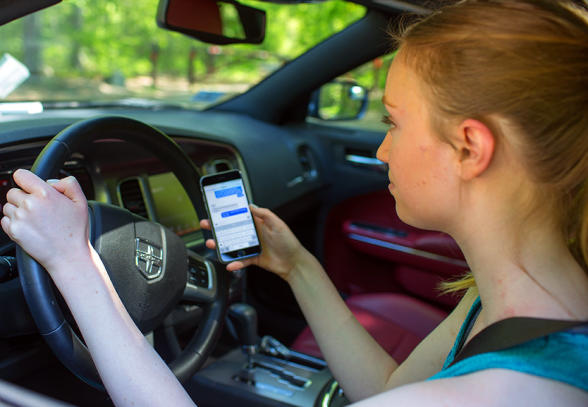Tech Working to End The 100 Deadliest Days of Driving

Today's drivers are more distracted than ever and it's no surprise the consequences are growing. The most recent NHSTA data published in April stated that 3,179 people were killed and an estimated 431,000 injured in car collisions as a result of distracted driving in 2014. Furthermore, unfocused drivers caused 10% of all fatal car crashes and 18% of injury crashes. That percentage likely increased this year, as overall crash fatalities for the country were estimated to be 9.3% higher in 2015 than the previous year.
Despite these alarming statistics, we are becoming more addicted to their phones, not less, and distracted driving continues to grow more rampant around the country. People are on their phones constantly—in fact, 70% of drivers admit to using their phone while driving. One study even suggests that distracted driving may very well be the "new drunk driving."
With the "100 Deadliest Days" already here—the period of time between Memorial Day and Labor Day that statistically has the highest number of collisions—it's time for big change.
What's the best way to combat this pervasive behavior? Laws and hefty fines may be increasing, but they aren't advancing or altering our driving behavior fast enough. Change is needed now and technology is the answer. Here's a look at the latest tech working to conquer bad driving.
Safe-Driving Apps
There is now a variety of driving apps available to help curb distracted driving. Some measure driver performance such as acceleration, turning and hard braking, while others are geared toward eliminating all phone use behind the wheel.
One app focused on improving drivers, EverDrive, monitors driving skills and allows you to compete with other drivers in your region. Users can review multiple aspects of their driving and improve their habits over time. The goal of mobile apps like this is to make drivers more conscious behind the wheel, in a fun and competitive manner, and as a result, decrease distracted driving rates across the country.
For those who don't trust themselves to keep their cell phones down, or find Facebook, Instagram and SnapChat to be too enticing, mobile apps like LifeSaver and CellControl may be the perfect fix. They both block cell phone usage while driving by locking the phone screen and operating silently in the background. CellControl also uses an in-vehicle device, and both offer an emergency phone call or text option in case of a crisis.
Another app, Down for the Count, allows drivers to pledge to keep their phones down for a noted period of time. They can then request a sponsor, such as a parent or friend, to start a safe driving campaign. Once the driver successfully reaches their goal, they receive a gift card as a reward.
Improving drivers' behavior on an individual basis may be the strongest bet for reducing distracted driving. If enough people are intrinsically interested in improving upon their skills or at the very least, in testing them, then the roads may become safer. Currently, 60% of United States drivers are distracted behind the wheel every day.* Many drivers may think that they're only picking up their phone once in awhile, but in reality, that's not the case. It only takes a second with your eyes off the road to end up in a potentially fatal collision.The safe-driving tech is here, but first, we need to want to improve. For drivers who struggle with self-motivation, there is other technology available that will work for you.
Driver Assistance Technology
For those of us who can afford a newer car with all the bells and whistles, driving assist technology may be the ideal solution to curb distracted driving. Every day, more vehicles are being sold equipped with a form of driver assistance, and the technology is no longer reserved for upgraded car packages. Known as Advanced Driver Assistance Systems (ADAS), these driver assist features can include everything from rearview cameras to automated braking and blind spot monitors.
Subaru, for example, now offers Eyesight Systems which includes pre-collision braking, lane swaying detection, adaptive cruise control, and even pre-collision throttle management to help lower the impact of a crash. The Tesla Model S has a similar system that notifies drivers if they exceed the speed limit and vibrates the steering wheel if a driver begins to lane drift. Additionally, Honda Sensing is now available in multiple models and offers lane keeping assist, forward collision warning, collision mitigation braking and more.
All of these features will help improve road safety, and ideally, help drivers improve upon their own skills. Something as small as a blind spot camera can make a real difference on roadways. Of course, drivers still need to make the choice to put their cell phones down, and not get comfortable in relying on their car's intelligence to compensate. Measuring whether this technology is capable of changing drivers' behaviors is hard to estimate.
Not to be dismissed, self-driving cars will eventually stake their claim in the war against unsafe driving, as distracted drivers will no longer have to be drivers at all. Cars that drive perfectly according to proven algorithms will likely create safer roads. However, it may be 15-20 years before drivers experience their full effect and we need safer roads now.
With the distracted driving accident rates growing daily, and the "100 Deadliest Days" already here, it's imperative we use the discussed apps and new car technologies to stay more focused behind the wheel. The right safe-driving tech is here, but drivers first need to decide to change. Too many innocent lives have been lost to continue to ignore this nationwide crisis. We have the technological solutions. It's time to use them.
*United States drivers refers to the percentage of EverDrive users who drive distracted each day.
